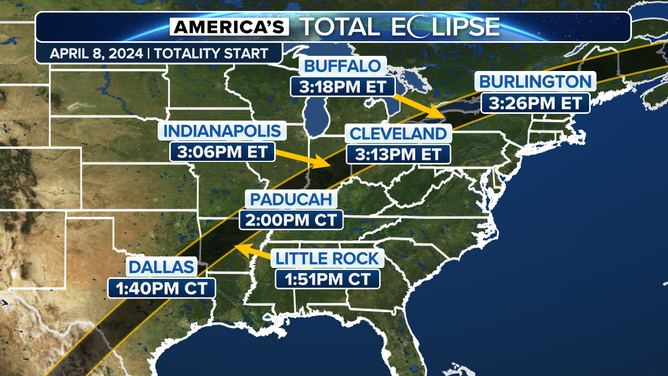More Texas communities issue disaster declarations ahead of Great North American Eclipse
Communities across at least three countries have planned special viewing events for the total solar annular eclipse on April 8. More than 30 million Americans are estimated to live in the path of totality, with many millions more expected to travel to the 15 states where the event will be fully visible.
Texas county declares state of emergency ahead of America's total solar eclipse in April
Bell County Judge David Blackburn joined FOX Weather on Sunday to explain how the Texas county is preparing for a surge of visitors ahead of America’s total solar eclipse in April and why officials decided to declare a state of emergency ahead of the event.
AUSTIN, Texas – More communities across the Lone Star have issued disaster declarations due to the threat their populations might triple as spectators around the U.S. grapple with what locale will have the best view of the Great North American Eclipse.
Officials in Kerr, Bell and Travis counties have stated that disaster declarations or state of emergencies will go into effect before a rush of visitors swarm the Central Texas communities on April 8.
The counties sit in what is called the path of totality, where the Moon will completely block the Sun for several minutes, leading to temporary darkness.
More than 30 million Americans are estimated to live in the path of totality, but for most of the Lower 48, only a partial eclipse is expected to be visible, leading many to plan excursions to parts of some 15 states.
"We expect that kind of visiting traffic here to cause extreme traffic congestion on our roadways, place an enormous strain on our first responders and hospital systems, drain our food and fuel supplies and strain our city and county infrastructure to, quite possibly, over capacity," Kerr County Judge Rob Kelly stated.

A map of the total solar eclipse path and totality start times across some U.S. cities.
(FOX Weather)
TEXAS COUNTY DECLARES STATE OF EMERGENCY AHEAD OF GREAT NORTH AMERICAN ECLIPSE
Other cities that are in the path of totality outside of the Lone Star State include Little Rock, Indianapolis, Cleveland, Buffalo, and parts of Syracuse.
In Central Texas, the eclipse will begin just after noon local and reach its maximum extent about an hour later. The episode of complete totality is expected to last for less than 4 minutes and varies by location.
In downtown Austin, the start of the eclipse is expected to begin around 12:17 p.m. local time, with totality starting around 1:36 p.m. The peak is expected to only last for less than 2 minutes, and the entire event will be over just before 3 p.m.
During the eclipse, spectators are strongly encouraged to wear specialized safety glasses if they plan to look directly at the Sun.
According to ophthalmologists, looking directly into the giant star can damage your retinas, leaving you with permanent vision loss.
The American Astronomical Society (AAS) has compiled a list of suppliers of glasses and other filters that can be used on the big day.

HOUSTON, TEXAS - OCTOBER 14: Astronauts answer questions via live video feed from the International Space Station in the background as people view the eclipse during the Space Center Houston Annular Eclipse Celebration and viewing event at NASAs John Space Center Saturday, Oct. 14, 2023.
(Kirk Sides/Houston Chronicle via Getty Images / Getty Images)
WHAT YOU NEED TO KNOW ABOUT APRIL’S SOLAR ECLIPSE
In addition to eye protection, local officials are warning residents to prepare as if a natural disaster is on the way, so they don’t get caught off-guard by the increased traffic and demands for food, gas and other supplies.
"I encourage you to stay off the roads and at home, if possible, on the day of the event. Also, in the week preceding the event, I would encourage you to make sure your vehicles are tanked up, that you have sufficient grocery supplies, that your prescriptions are filled and that you are stocked up on provisions for any animals in your care over the duration of eclipse weekend," Kelly stated.
If you miss April’s event, the next wide-reaching total solar eclipse won’t happen until 2045, when the path of totality will start over the Pacific Ocean and travel over the country through the East Coast.
